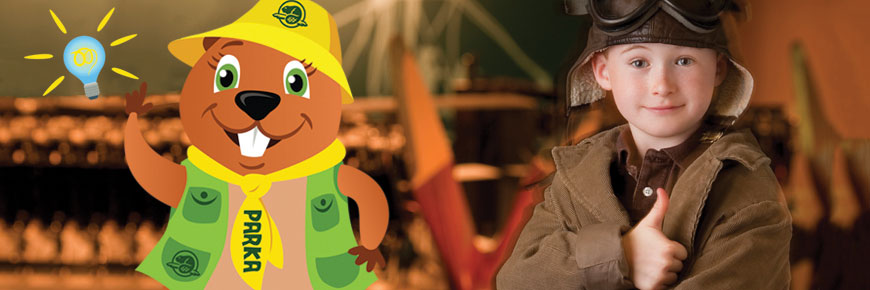
Fun Experiments for Little Inventors
By Valerie Mason, Alexander Graham Bell National Historic Site, NS
Have you ever heard of Alexander Graham Bell? If this name doesn’t ring a bell for you, maybe it rings a phone… like the very first telephone ever invented!
Although the telephone might be Bell’s most famous invention, earning him international recognition, he also contributed to the development of the modern world in many other ways: from planes, to kites, to the education of those with hearing impairments, to artificial respiration – Bell certainly conducted many successful experiments!
At the Alexander Graham Bell National Historic Site, we delve into the passions of this creator, and even recreate some of his achievements. Tetrahedral kite, anyone? You’ll have to come visit and make one for yourself!
Until then, here are a few simple and fun experiments you can do at home with the whole family. Just as Mr. Bell used to work on them with his grandchildren, so too would we recommend working with your little ones to complete the experiments, especially during the steps that involve matches or needles.
Ready to go? Happy discovering!

Experiment 1 - How to Make a Telephone
Did you know you can make your own telephone with objects from around the house? Read on to find out how!
Material
- Two plastic cups
- A piece of string or fishing line that is at least 4 metres (12 feet) long
- A needle or other object that can pierce a small hole
- A piece of fabric or wood (Optional)
- Markers and stickers (Optional)
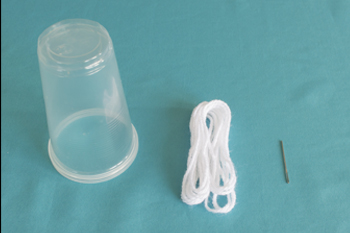
Instructions
- Pierce a hole in the bottom of each cup, making sure that the hole is big enough to allow string to be threaded through (this may be a job for an adult).
- Thread the string through the hole of one cup, and tie a knot at the end protruding from the inside of the container (make sure the knot is securely fastened. If you are using fishing line, you will have to reinforce the knot with a piece of cloth or wood so that it does not slip out).
- Take the other end of the string and repeat the process with the second cup.
- If you would like, this can be a good time to decorate the telephone with markers or stickers! (Optional)
- Now you’re ready to put your creation to the test. Keep one end of the telephone for yourself, and give the other to your fellow experimenter. Walk away from each other until the string is taut.
- To place a call, have the person at the other end put their cup to their ear while you speak into yours. Then switch it up to hear their reply!
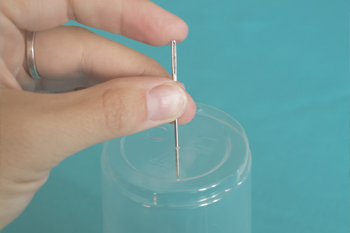
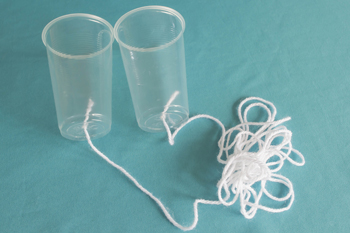
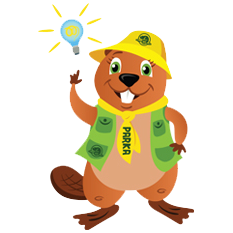
Why does it work?
When you speak, the sounds you make are created by waves, which you can imagine as vibrations or tiny twitches. You may not be able to see anything, but if you’re making noise, then you’re making waves!
When you speak into the cup, your voice hits the bottom of the container, which then starts to vibrate. These vibrations travel through the taut string, from one end to the other end, and when the vibrations reach the bottom of the other container, they become waves that the other person can hear and understand.
No need to shout for your fellow experimenter to hear you either – sound actually moves much better in solid objects than through the air!
Experiment 2 - How to put an Egg in a Bottle without touching
Can an egg be squeezed into a bottle without being forced in? Find it out with this fun and a-little-bit-noisy experiment! We recommend adult assistance for this experiment.
Material
- A hardboiled egg, without the shell
- A bottle of milk (or something similar) with a narrow neck (the inside must be completely dry)
- A piece of paper or paper towel
- Matches or lighter
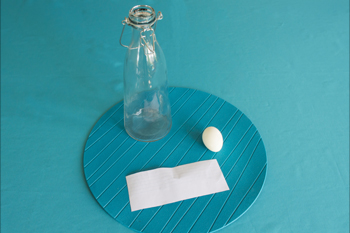
Instructions
- Loosely fold or crumple the piece of paper or paper towel in a long narrow shape so that it fits through the bottle opening.
- Hold the egg ready to place it on top of the bottle. This next part moves very fast, so make sure all participants are set!
- Light the paper on fire and place it in the bottle. (this should be a job for an adult)
- Before the fire goes out, place the egg on top of the bottle, and remove your hands.
- Watch and wait for the “POP”!
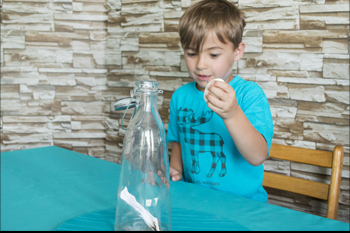


Why does it work?
In the air all around us, there are gasses we cannot see, one of them being oxygen. In the bottle, there is also air, and therefore oxygen.
Much like we need oxygen to breathe, a fire needs oxygen to burn. By blocking the opening of the bottle with the egg, the fire will quickly consume or absorb all the oxygen, and when this happens, the air outside your bottle will push or press the egg in.
And before you know it, you’ve got an egg in a bottle, without forcing it in yourself!
Experiment 3 - How to do magic with a glass of water
Can water float in the air? Make your own little bit of gravitational magic by checking out this experiment!
Material
- A glass of water or plastic cup
- A piece of construction paper
- A pair of scissors
- Enough water to fill the cup
- An empty container, dish, or bowl
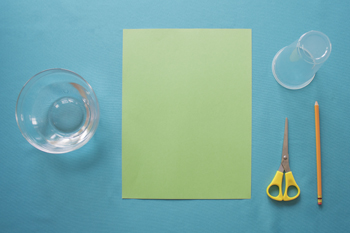
Instructions
- Trace a circle on the construction paper that’s roughly ½ inch larger in diameter than the brim of the cup, and cut it out.
- Working over the empty basin, fill the glass with water.
- Place the circle over the brim of the cup, making sure it is completely covered.
- Place your hand firmly on top of the circle to hold it in place, turn the cup upside down very quickly and remove your hand slowly.
Is the water "magically" holding in the cup or did it end up splashing everywhere? It might take a few tries to get it right, so be sure to give it another shot!
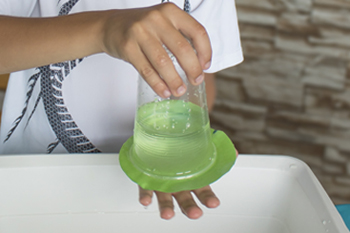


Why does it work?
This experiment works thanks to atmospheric pressure! This pressure is all around you, meaning that the air is pushing in all directions, even if you don’t feel it – it’s what keeps your feet on the ground, instead of floating around in space!
When you turn your glass upside down, the atmospheric pressure pushes on the paper under the glass and prevents the water from splashing out. So in the end, it looks like water really can float on air!
Download these activities (PDF, 738 KB)
- Date modified :